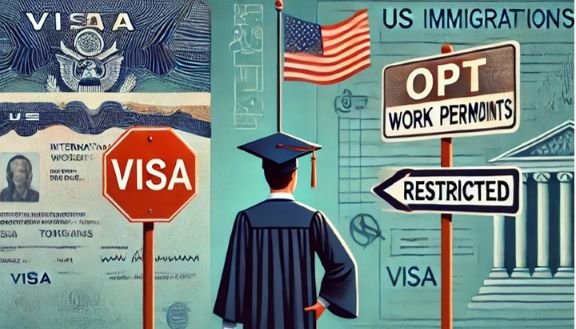Indian Students at Risk as US Considers Tighter Rules on OPT Work Permits
The future of thousands of Indian students in the United States is facing uncertainty as policymakers debate potential restrictions on the Optional Practical Training (OPT) program which grants OPT Work Permits, a crucial pathway that allows international students on F-1 visas to gain work experience and transition to H-1B visas. With critics arguing that the program gives an unfair advantage to foreign students over American graduates, nearly 69,000 Indian students could be affected by possible regulatory changes.
OPT and CPT: Key Pathways for International Students
The Optional Practical Training (OPT) and Curricular Practical Training (CPT) programs have long served as vital employment channels for students pursuing higher education in the US.
- OPT permits international students to work for 12 months before or after graduation, with STEM students receiving an additional 24-month extension, totaling up to 36 months of work authorization.
- CPT, on the other hand, is designed for work experience that is integral to a student’s curriculum and can be pursued on a part-time or full-time basis. However, students completing over 12 months of full-time CPT become ineligible for OPT.
Both programs require approval from Designated School Officials (DSOs) at universities, and OPT applications must also be approved by the US Citizenship and Immigration Services (USCIS).
Why Are OPT and CPT Under Scrutiny?
The US House Judiciary Committee recently held a hearing on January 22, 2025, where Jessica M. Vaughan, Director of Policy Studies at the Center for Immigration Studies, strongly criticized OPT and CPT. She alleged that these programs are not authorized by Congress, are exploited by diploma mills issuing fake work authorizations, and should either be eliminated or subjected to stringent regulations. Vaughan also pointed out that the programs have created the largest guest worker population in the US, with over 540,000 former students working without adequate oversight.
Adding to the controversy, in 2022, WashTech, a workers’ alliance, filed a lawsuit against OPT, claiming it allows employers to bypass H-1B visa caps, negatively affecting job opportunities for American workers.
Concerns over fraud and national security risks have further fueled calls for reform. In 2016, the US Department of Homeland Security exposed a scam by setting up the fake University of Northern New Jersey, which uncovered fraudulent CPT applications.
Proposed Changes and Their Potential Impact
The numbers highlight the scale of the issue. In FY 2023, a total of 539,382 foreign students worked under OPT, STEM OPT, and CPT:
- 276,452 students participated in OPT
- 122,101 students benefited from the STEM OPT extension
- 140,829 students worked under CPT
Unlike the H-1B visa, which has an annual cap, OPT and CPT have no limits on participation. Given the program’s scale, policymakers are now considering measures such as:
- Stricter oversight of universities issuing visa paperwork
- Revoking certification for institutions with high visa overstay rates
- Restricting OPT eligibility to fields where practical training is necessary
Universities and Tech Giants Push Back
Universities and businesses, however, have strongly opposed the proposed changes. Many academic institutions, including the University of California, Berkeley, argue that OPT is critical for attracting international students who contribute significantly to the US economy.
Leading tech companies, such as Google, Microsoft, and Amazon, have also voiced concerns, highlighting that OPT plays a crucial role in hiring skilled international graduates, especially in high-demand sectors like software engineering, data science, and product management.
What Lies Ahead?
As the debate over OPT restrictions continues, Indian students and professionals in the US remain uncertain about their career prospects. With 69,000 Indian students participating in the program in 2022-2023, any significant policy changes could alter the landscape of employment opportunities for international graduates.
While universities and corporations advocate for the retention of OPT as a bridge to skilled employment, critics insist that regulatory reforms are needed to ensure job opportunities for American graduates. The coming months will be crucial in determining whether OPT remains a viable pathway for international students or faces tighter restrictions under the new policies.
Also see:
Indians Dominate H-1B Visas: 72% of Allocations Between Oct 2022 & Sept 2023
H-1B Visa Registration Opens on March 7; Fee Hike
Trudeau Calls Trump’s Canada Annexation Threat a “Real Concern”
Gautam Adani Donates Rs 10,000 Crore to Social Causes at Son’s Wedding
—————————————————————
It would mean the world to us if you follow us on Twitter, Instagram and Facebook




